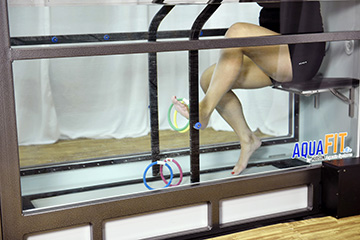Aquatic Therapy for TKA Patient
Posted
With an estimated 600,000 Total Knee Replacements occurring each year in the United States, developing the best rehab and recovery protocols for a quick and safe return to a normal life are critical.
Beginning aquatic therapy early, as soon as 6-days post-op, has proven beneficial in many cases. While infection is a concern with post-op patients before the incision is fully healed, it doesn’t have to be a contraindication. By utilizing waterproof dressings and taking the proper precautions, the risk of infection is reduced. In a meta-analysis article from the Archives of Physical Medicine and Rehabilitation, results show that early aquatic physical therapy improves function and does not increase the risk of infection in adults after orthopedic surgery. Read the full article for more information.
Why Aquatic Therapy?
- • When compared with standard land-based physical therapy for TKA patients, aquatic therapy resulted in a significant improvement on measures of ADLs (activities of daily living)
- • Clinical Significance: The ability to perform ADLs with less pain and difficulty is a top priority for the older population with arthritis.
- • Aquatic therapy is just as effective as land-based therapy for treating other problems associated with orthopedic complaints including weakness, edema, limited ROM, pain and gait abnormalities.
Treatment Benefits for the TKA Patient:
- • Address Abnormal Gait Pattern: Aquatic therapy allows both the patient and therapist to focus on normalizing gait in a safe environment with reduced risk for falls. Buoyancy unweights the patient to allow for focus on gait pattern with reduced weight bearing through the surgical limb and decompresses the joint resulting in decreased pain.
- • Excessive Use of Assistive Device (AD): Patients who rely heavily on an AD for balance or for weight distribution can utilize buoyancy to decrease fall risk and focus on gait training in a safe environment without the use of an AD.
- • Post-Op Edema Limiting ROM: The hydrostatic pressure from the water is equally as effective as land-based therapy in reducing edema to increase ROM.
- • Limitations in a gravity dominant environment: Patients that struggle to complete exercises against gravity secondary to weight bearing restrictions, increased pain, inability to support weight for gait training activities secondary to weakness/obesity/ect. experience better outcomes with aquatic treatment.
Why it works: The properties of water provide unique benefits that can’t be imitated on land
- Buoyancy:
• Decreases compressive forces through the ankle, knee, and hip
• Increases ease of handling and position (beneficial for therapist)
• Decreases/eliminates need for assistive device
2. Thermal Shifts- Warm Water:
• Decreases muscles spasms and pain
3. Hydrostatic Pressure:
• Decreases edema
• Increases cardiac efficiency
• Increases work of breathing (strengthens respiratory muscles for deconditioned patients)
4. Viscosity:
• Increases strength proving 360 degrees of even resistance without the use of equipment
• Increases sensory input
• Decreases fear of falling
Utilizing aquatic therapy throughout the rehab process for TKA patients has many benefits including quicker recovery times with less pain than land-based treatments alone, increased independence and confidence with ADLs, and benefits the cardiovascular system for deconditioned patients. With the number of joint replacements rising each year, help your patients to have a quicker and more successful recovery by adding aquatic therapy to TKA treatment plans.




